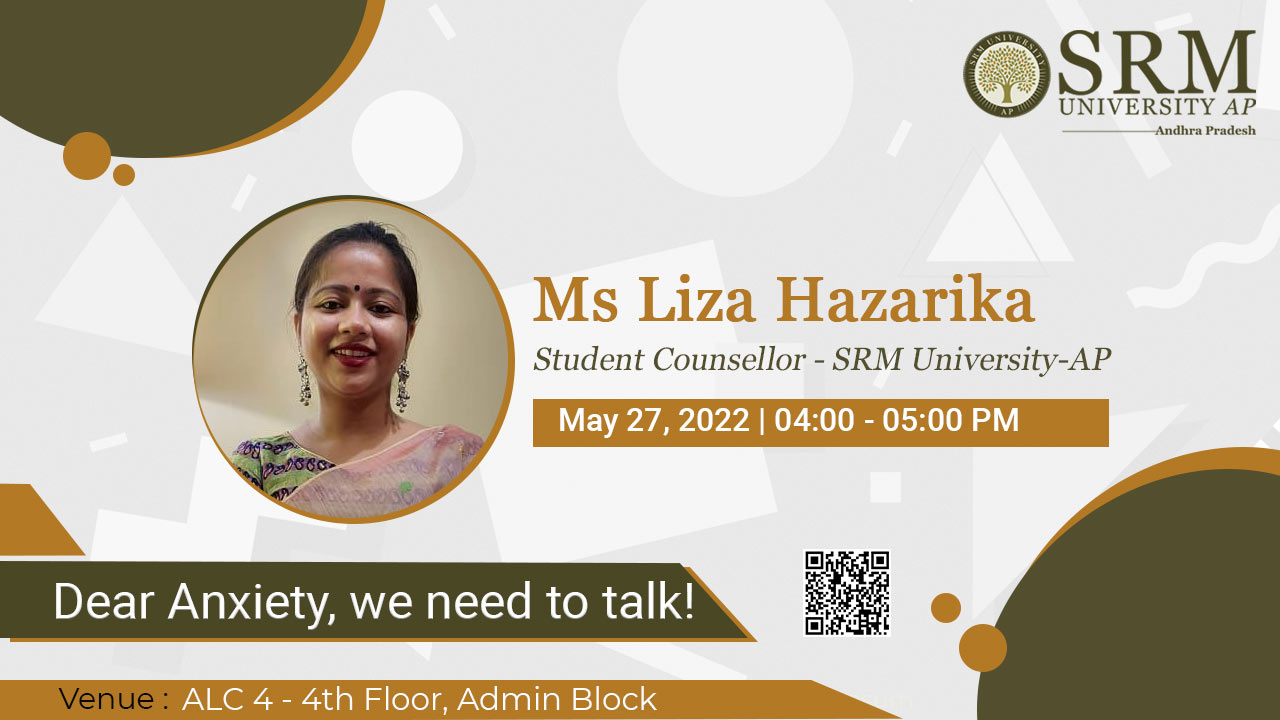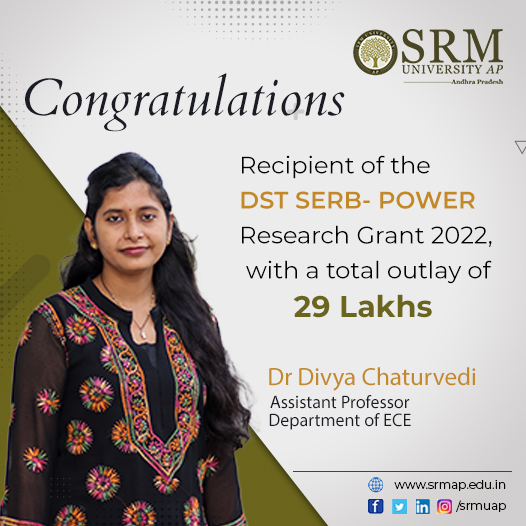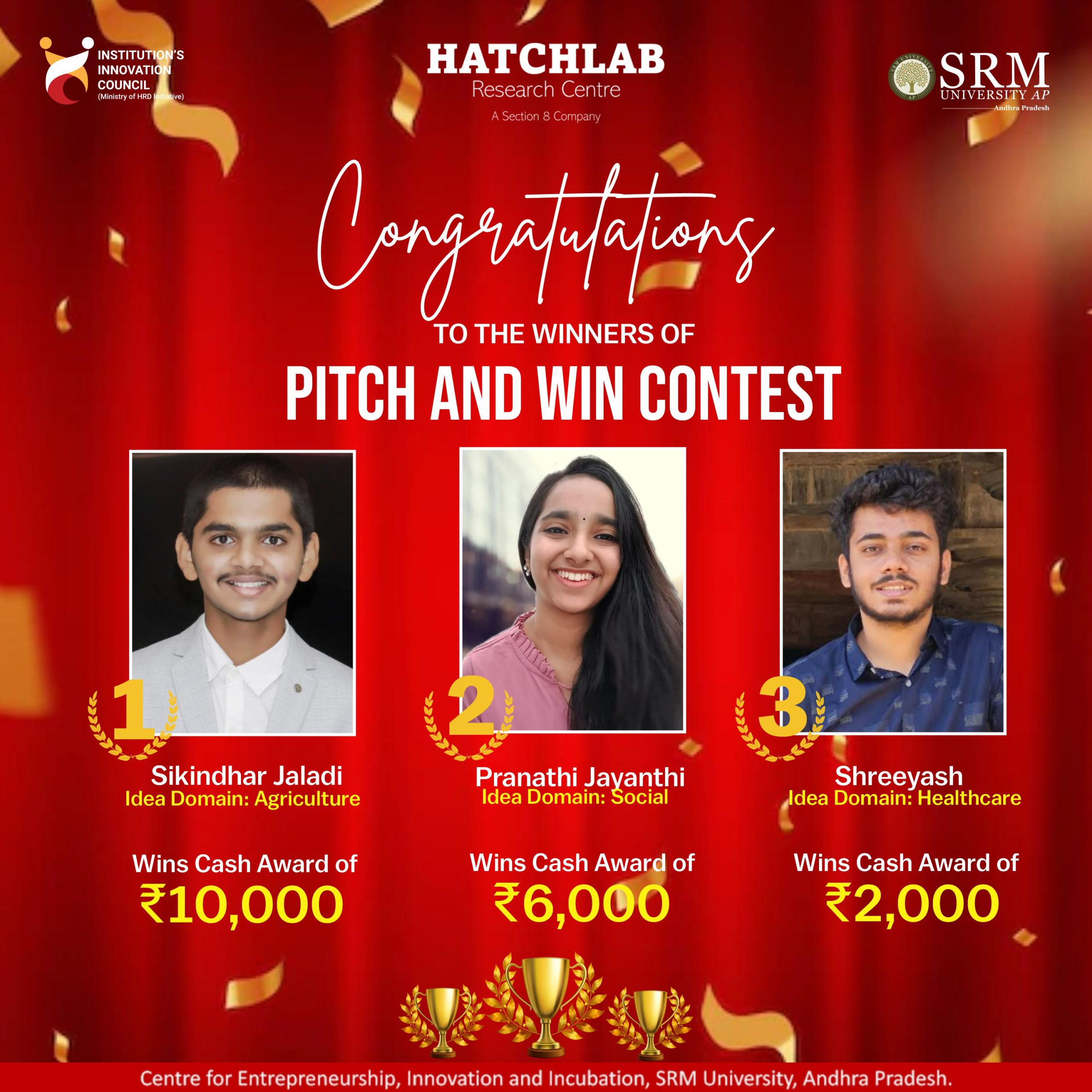- Dear Anxiety, we need to talk! May 26, 2022
 Fear of being in confined areas, fear of failure, fear of speaking out- anxiety manifests in a variety of ways. Don’t be anxious about your anxiety. SRM University-AP ensures our students’ mental well-being through the services of resident counsellors.
Fear of being in confined areas, fear of failure, fear of speaking out- anxiety manifests in a variety of ways. Don’t be anxious about your anxiety. SRM University-AP ensures our students’ mental well-being through the services of resident counsellors.May is a month dedicated to raising awareness about mental and behavioural health disorders, as well as eliminating the stigma that many people face. This month, our student counsellor Ms Liza Hazarika interacts with students on the topic “Dear Anxiety, we need to talk!” on May 27, 2022
Time: 4.00 to 05.00 pm IST
Venue: ALC 4 – 4th Floor, Admin Block
Come, participate and learn the ways to hold on to hope.
Continue reading → - CR&CS endorses MoU with Miraist for Academic Alliance Programme May 26, 2022

The Department of Corporate Relations & Career Services at SRM University-AP collaborates with Miraist Pvt. Ltd. for the Academic Alliance Program. Under this academic alliance program, the students of SRM University-AP will be offered training in Japanese language and an enviable opportunity to work in Japan.
Miraist is a leading HR recruitment firm in India catering to Japanese industries with end-to-end professional service. This is an excellent opportunity for our students to demonstrate the cutting-edge training they received here in Japanese Industries. Miraist and the Japanese clients will interview the aspiring candidates. Upon receiving the offer, all the successful candidates will be given Japanese training sessions.
Representatives from Miraist Pvt. Ltd. expressed their gratitude to Dr R Premkumar-Registrar, Mr M S Vivekanandan, Associate Director- Corporate Relations & Career Services and Mr P. Venkateswara Rao-Senior Manager, Internship, Corporate Relations & Career Services for making this collaboration possible.
- Dr Divya Chaturvedi steps up her research with SERB-POWER grant May 25, 2022

Dr Divya Chaturvedi from the Department of Electronics and Communication Engineering has been awarded the SERB-POWER research grant that amounts to a total of 29 lakhs for a period of three years. The grant was sanctioned for her research titled “Development of Breast Cancer Detecting System Based on Microwave Antenna-Array-Sensors and its Implementation to Internet of Medical Things (IoMT)”.
SERB- POWER (Promoting Opportunities for Women in Exploratory Research) research grants is a scheme initiated by the Government of India with an aim to encourage emerging and eminent women researchers for individual-centric and competitive mode of research funding to undertake R&D activities in frontier areas of science and engineering.
Her study on developing a breast cancer detection system has gained immense attention due to the global increase of the malady in recent decades. It has become the most common cancer diagnosed in women across all age groups. Despite the different tests such as Mammograms, ultrasound, and MRI available to diagnose the disease, there has been little considerable improvement in bringing down the caseload.
Dr Divya’s research intends to develop an advanced detection technique based on Antenna-Array-Sensors and she is attempting to put it into implementation through the Internet of Medical Things (IoMT). Connecting the medical devices to healthcare IT systems through online computer networks will allow the easier and quicker detection of the defect. This may go down as a milestone achievement in the medical domain.
The research grant will help in building better- equipped research lab with the most modern amenities and hiring more manpower to fulfil the project objectives. In the words of Dr Divya, “Better research facilities will aid the faculty in performing various experiments. They will save their travelling time to other universities for accessing research infrastructure. The students can also avail the advantage to intensify their research initiatives”. Through the project she envisions to establish a collaborative dedicated research group that will help in fulfilling the various objectives of the project.
Continue reading → - Tracking the growth of health expenditure in the Middle East May 25, 2022

Middle East countries are characterized by a growing burden of chronic diseases such as diabetes, cancer, cardiovascular diseases, and respiratory diseases in recent times. These are health conditions that require regular access to care in order to lower their morbidity and mortality burden. Hence, healthcare-focused research and development spending has the potential to uncover new methods for the diagnosis and treatment of different health conditions, lower their cost of care, along with reducing morbidity and mortality burden in the population.
Having conducted comprehensive research in this regard, an article titled “Predicting Key Drivers for Health Care Expenditure Growth in the Middle East Region: A Grossman-PLS Modeling Approach” has been published by Dr Shailender Singh and his PhD scholar Mr Muhammad Muazu Bala from the Department of Commerce. It was published in the Journal, ‘Expert Review of Pharmacoeconomics & Outcomes Research’ having an Impact Factor of 2.31. The research was led in collaboration with Dr Nishant Kumar from Amity University, Noida.
The results obtained from the study show that the supply side of care (HSCI) has contributed more than the demand side (SDI) in determining the overall level of health care expenditure of the Middle East countries. This implied that massive investment targeted at achieving high-quality healthcare systems is more noticeable in determining the overall level of health care expenditure. Though progress towards a high-quality health system is a desirable health care goal, particularly for LMICs (Low- and middle-income countries), available evidence shows that expenditure on research and development is quite low.
The study recommends an expansion of health insurance coverage to induce greater utilization of health care services particularly among the aging cohort of the population. The promoters of Universal Health Coverage (UHC) such as the World Health Organization (WHO) and the World Bank have emphasized that obtaining health insurance coverage will induce greater access to health services without facing financial hardships. In line with the findings of this study, since real wage is statistically significant, mandatory employment-based health insurance may induce greater utilization of health services and provide financial risk protection for formal sector employees.
However, this alone will not suffice to achieve greater improvement in health outcomes, especially for LMICs characterized by the largest share of informal sector employment. Thus, other forms of health insurance such as community–based health insurance may help to cover the informal sector and the vast segment of the population that lives in rural areas. Moreover, other pro-poor publicly financed health care payment mechanisms could be a promising path for promoting access to health services and guaranteeing financial risk protection for the poor.

The research infers that health system stakeholders in the Middle East should prioritize exploiting the available resources for strengthening the capacity of their health systems. Also, available data shows that expenditure on research and development is quite low and thus should be considerably increased so that new inventions, innovations, and discoveries could be unleashed for better understanding, treatment, and diagnosis of different health conditions for improving health outcomes.
Abstract of the Research
Initially, this study provides empirical evidence to the Grossman theoretical model using macro-level panel data for 15 countries of the Middle East region from 2000 through 2016. During the second phase, contradistinction analysis is executed and a parallel model of the demand for care as a function of health system capacity indicators is estimated. Lastly, for robustness checks, a new predictive model is developed carrying forward the outcome from Grossman and the parallel models. A variance-based partial least square structural equation modeling (PLS-SEM) is applied to analyse the interaction between health expenditure and the latent construct: socio-demographic factor and health system capacity. Results elucidate that the relative wage rate and the ageing variables are the only indicators that are statistically significant with theoretically consistent signs as postulated by Grossman’s theoretical model. The exact opposite is true with schooling and the proxy of the medical care relative prices. However, in the parallel model, all the four drivers of the demand for care are statistically significant with robust standard errors. Therefore, the Middle East’s data has comparatively a better fit in the parallel model than it does in the Grossman model. Also, the integrated estimation model supports the results of the separate models.
- Top 3 winners of the ‘Pitch and Win’ contest May 24, 2022
 Solving the problems existing in diverse domains through innovative ideas is something only certain people will be able to do. Earlier this year, the Department of Entrepreneurship and Innovation held a Pitch and Win contest, which invited ideas to solve problems across the six major domains. Sikindhar Jaladi, Pranathi Jayanthi, and Shreeyash made it to the top three with their excellent competitive skills and ideas.
Solving the problems existing in diverse domains through innovative ideas is something only certain people will be able to do. Earlier this year, the Department of Entrepreneurship and Innovation held a Pitch and Win contest, which invited ideas to solve problems across the six major domains. Sikindhar Jaladi, Pranathi Jayanthi, and Shreeyash made it to the top three with their excellent competitive skills and ideas.The domains from which the applications were invited included Education, Deep-Tech, Social, Health, Alternate Energy, Retail, Fintech and so on. The top three winners were selected from hundreds of contestants. Also, top 10 applications are selected to be incubated at the Hatchlab Research Centre. They will be nurtured for a period of 18 months and transformed from an idea to a prototype. This will again be developed into a complete product with industrial exposure and corporate mentorship along with seed funding of Rs. 500000 (to the eligible ventures) from the university. A cubical will be allocated to each team to sit and build their products and work on the venture.
Continue reading →

